Healing 1: Serving the Hungry with an Understanding Heart
“You, God, are my God, earnestly I seek you; I thirst for you, my whole being longs for you, in a dry and parched land where there is no water.” – Psalm 63:1
“That person lives in Shandaken. He shouldn’t even be here.”
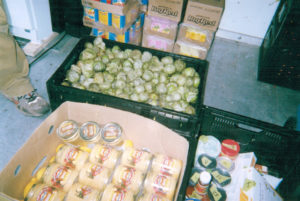
The pantry served shoppers, volunteers, hungry people. Volunteers fed everyone in the line. No exceptions.
Distributing groceries brought forgiveness and healing. Healing was an after thought of forgiveness.
For me, healing required some commitment and thought. Whether or not this was true, questions always arose:
“Am I ready to be healthy?”
“Can I get well if it’s scary?”
“Can I leave the old me aside if it’s necessary for healing?”
“Why am I going through this?”
“What is the meaning of it all?”
These questions could be painful. Healing can be hard on everyone.
The pantry line had massage therapists, Reiki practitioners, medical intuitives, and other healers.
As a healer, I know healing happens on several levels in our lives: physical, mental, spiritual, emotional, mythical. Both healing and getting well were special challenges because many of the people in the hallway, the pantry room, and out in the parking lot didn’t have health care.
While he had his office, Woodstock had Dr. Longmore. After his office closed, things were tough for many. As health care became scarce, everyone became personally involved with the differences between healing and getting well. For some, this was part of the spiritual journey.
Hunger often went beyond a plate of beans or a jar of peanut butter. That’s why food is essential to healing. That’s where homemade soup comes in.
Sharing food in the pantry helped people heal. Fresh vegetables, eggs, and Bread Alone bread offered a healing experience with abundance. As we fed the shoppers, we helped ourselves and each other.
In some cases, the shoppers became the volunteers or the volunteers joined the shoppers. Shoppers came to get food and found they could volunteer. Volunteering changed them. As a person distributed groceries, the volunteer made contact with another person and was able to smile.
Pantry experiences coaxed us out of our own problems. Offering a sense of community gives back so much more.
Do you want to be healed? Healing and feeding are connected.
Sooner or later, we all get sick. Finally, we die.
No one escapes. This truth is harder on hungry people who have no $$$ for health care.
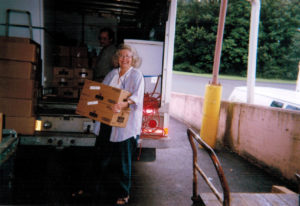
Hungry people are often blamed for their inability to deal with the situation. It’s as if it’s their fault for being down and out in Woodstock. If they lived right, they would be healthier, make more $$$ in their jobs.
If critics stopped and thought about how insufficient nutritious food, improper housing, and inadequate or nonexistent healthcare impacts a person, they might feel differently.
What did it matter that there were no jobs in the area and none of those that came open paid over $8.00 an hour?
Because they were down and out, they must be guilty of something.
They were negative thinkers, lacking faith, and basically lazy. Something.
They were gay, trans, promiscuous, alcoholics. Something.
They were freeloaders, irresponsible, flaky. Something.
Healing and getting well are two different things, acting in different ways. But, whether a person heals, gets well, or both, change happens.
“Do I want to heal?”
“Do I want to be well?”
“What if I come out of this experienced a different person?”
“What if it takes a long time?”
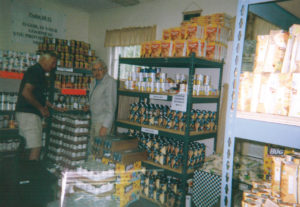
In the midst of this, the pantry offered some normalcy to the shattered lives of hungry people when they took pantry food home to wherever and whatever that was, fixed a meal, and served it to those in the household.
It was supper from the pantry.
Health issues pointed to the spiritual challenges which popped up on the path to the pantry. Healing was on the agenda. We all wanted to get well.
People getting well overcome symptoms. Getting well means doctor’s visits, therapy, pills, creams. These things were simply not an option for pantry shoppers because there was no money.
Symbolic healing occurred in the hallway on pantry days as shoppers and volunteers discussed their diabetes, PTSD, cancer, allergies.
Working and shopping in the pantry was therapy to volunteers and shoppers. These hallway conversations were cheaper than the physical and mental health services they had no money for anyway.
These conversations were essential because talking about a health issue promotes healing. Shared symptoms gave us all support, strength, validity.
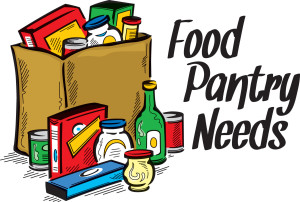
Everyone walking through the door to the pantry, whether a shopper or volunteer, was asked to leave the past behind. This experience was different for everyone. But, think about it, how can we move forward into our new lives if we never give anything up.
For some, giving up the past means letting go of things lost: the job, the home, maybe the family, self-esteem, the car, good health, money, insurance, the pet, anger, or drugs.
As the past disappears, the remaining spiritual baggage weighs less and less. Prejudices become fewer. Fears diminish. We heal!
Some things surrendered were physical, some mental, and some emotional. But, one thing is certain, whatever the category, the experiences all had a spiritual aspect.
Giving and receiving food brought everyone a little peace.
Everyone coming to the pantry heals somehow. The pantry community supports and approves hungry individuals as they climb back on the road to wellness and something offering normalcy.
Nobody just wakes up one day and says “I think I’ll go down to the local food pantry and volunteer.” People spending time in pantries all travel down the path. Healing has signposts along the way.
Some needed physical healing. Volunteers occasionally came to the pantry so ill that they were barely able to make it into the building. When this happened, I stationed them at the Items of Dignity table distributing toilet paper, shampoo, razors. They offered one roll of toilet paper and one other item to each shopper.
 Each week, Deanna slowly walked the two blocks to the pantry and then worked in the hallway a couple of hours while she gathered enough energy to return home.
Each week, Deanna slowly walked the two blocks to the pantry and then worked in the hallway a couple of hours while she gathered enough energy to return home.
“Don’t forget your roll of toilet paper, Judith. We’ve got some hand cream today. Can you use that or would you prefer tooth paste?”
When Deanna finally couldn’t work in the hallway anymore, Rachel gracefully sat at the Items of Dignity table helping shoppers choose their two items. Rachel lived in nearby Mt. Tremper. Her living situation seemed somewhat precarious because every few months she looked for a new place to live. She lived in her car a couple of times.
Thank you for reading this blog post. This is the first food pantry article on healing.
Please forward this article with your preferred social media network. Share it with a friend.
If you are interested in healing, please check out my other blog: www.reflexologyforthespirit.com.
Thanks again.
Thurman Greco
Woodstock, NY
PS: Many programs are now uploaded to YouTube. More are being added weekly. Enjoy!
![]()
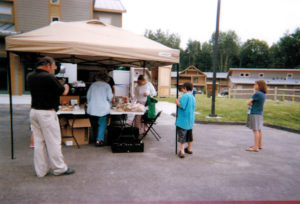

No Fixed Address

“No Fixed Address” is dedicated to those in our country with no roof over their heads. See your neighbors, your friends, your relatives, in new ways as they describe their daily lives in their own words.
The people in this new book reveal themselves to be both brave and fearless as they go about their activities: work, laundry, children’s homework, appointments. Mostly they live like the rest of us. They just have no roof over their heads.
“No Fixed Address” is my newest book in the Unworthy Hungry series. It’s easy to read and understand. You won’t be bored, not even for a minute.
I hope you’ll order it today. Get an extra copy for a friend!
This book has an extra surprise. When you get a copy, you’ll be making a donation to a good cause. You’ll be fighting hunger and homelessness.
It doesn’t get much better than that!
Thank you for reading this article!
Please forward it to your preferred social media network.
Thurman Greco


Preventing Senior Hunger
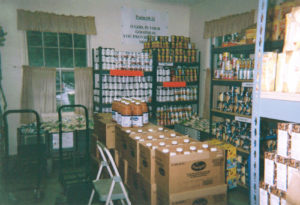
For years, I’ve been blogging and writing books about hunger in America in general and senior hunger specifically.
Senior hunger is not going away anytime soon.
If you read my blog posts, then you are probably interested in senior hunger. Recently I came across a guide which you will want to read.
To learn more about senior hunger, access it here: https://onlinegrad.baylor.edu/resources/seniors-food-insecurity-hunger/
Thanks for reading this article and thanks for your interest and action.
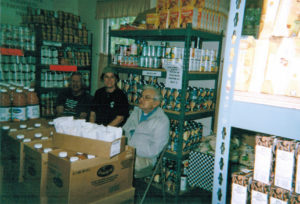
I hope you’ll not only read this article but will also share it wherever you feel it might be appropriate.
This new resource may be of interest to readers everywhere. The goal is to help open a dialogue in our country about senior hunger.
Thank you for your time and thank you for your concern about seniors and hunger.
Thurman Greco


Please share this post with your preferred social media network.
Homeless….2
“Homeless is not a category of people. It’s just a situation that happens. It can happen to anyone.” – Salvador Altamirano-Segura
GENE ESTESS died in April at 78. Mr. Estess is best known for abandoning a lucrative career on Wall Street to aid the poor, mentally ill, addicted people, and homeless in Harlem and the South Bronx. He directed the Jericho Project, a Manhattan-based nonprofit for 18 years. The Jericho project serves about 1500 adults and children, including many military veterans by offering housing and other services.
MIZUNO USA, a running shoe manufacturer, is introducing a new campaign to encourage running. Mizuno will partner with Back On My Feet, a national nonprofit organization which works with the homeless to transform their lives through running. Later this year, Mizuno will donate a dollar to Back On My Feet, for every mile a person runs for a week.
DR. PHILIP BRICKNER, a physician who made housecalls, died recently. Dr. Brickner is best known for helping to develop ways to treat homeless people.
Dr. Brickner began his unique focus on medical care in the late 1960’s when he set up “free clinics” at hotels and other places where homeless people lived.
His innovations became the basis for the McKinney-Vento Homeless Act of 1987. This act mandated medical services in shelters and food lines.
THE MISSION CONTINUES, a new organization composed of veterans returning from service in foreign wars, works to help fellow veterans. Service platoons now exist in approximately nine cities with plans to have service platoons in thirty cities by the end of 2014.
The 1st Platoon NYC is renovating housing for veterans and building a playground.
The 1st Platoon works with the Arizona Coalition to End Homelessness by combing the streets for chronically homeless vets and registering them to get housing and other services.
ANDREA ELLIOTT of the New York Times was nominated for a Pulitzer Prize for her impressive series “Invisible Child,” about the homeless girl named Dasani.
JAMES BOYD, a homeless man camping in the Sandia foothills outside Albuquerque, NM, was shot and killed at a protest in March. Mr. Boyd was a mentally ill homeless man. His death was captured on video by a camera attached to a police officer’s helmet.
Mr. Boyd’s death brings focused attention on the growing number of severely mentally ill people who are living without mental health services.
JEROME MERDOUGH, a 56-year-old Marine – homeless and suffering from mental illness – died while in custody on Rikers Island in February, 2014. Mr. Murdough died after being left unattended in his cell for hours while the temperature there climbed above 100 degrees.
Thank you for reading this blog/book.
Please share this article on your preferred social media.
Please send a comment.
Peace and food for all.
Thurman Greco




